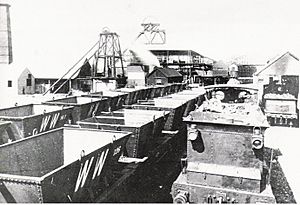West Wallsend facts for kids
Quick facts for kids West WallsendGreater Newcastle, New South Wales |
|||||||||||||||
|---|---|---|---|---|---|---|---|---|---|---|---|---|---|---|---|
| Population | 2,981 (2021 census) | ||||||||||||||
| • Density | 1,420/km2 (3,700/sq mi) | ||||||||||||||
| Established | 1860s | ||||||||||||||
| Postcode(s) | 2286 | ||||||||||||||
| Area | 2.1 km2 (0.8 sq mi) | ||||||||||||||
| Location | |||||||||||||||
| LGA(s) | City of Lake Macquarie | ||||||||||||||
| Parish | Teralba | ||||||||||||||
| State electorate(s) | Cessnock | ||||||||||||||
| Federal Division(s) | Hunter | ||||||||||||||
|
|||||||||||||||
West Wallsend is a small town and suburb in New South Wales, Australia. It is part of the City of Lake Macquarie in the Greater Newcastle area. The town is located near the Sydney-Newcastle Freeway. It is also close to the western suburbs of Newcastle.
Contents
A Look Back at West Wallsend's Past
The Awabakal people are the traditional owners of this land. They have lived in this area for thousands of years.
West Wallsend's Coal Mining Story
West Wallsend started because of coal mining. The main mine was called West Wallsend Colliery. The town grew up around this important mine. In 1885, the West Wallsend Coal Company was created. It bought a large area of land, about 2,972 acres (12 square kilometers). A deep shaft, about 492 feet (150 meters) deep, reached a coal seam. This coal seam was almost 5 feet (1.5 meters) thick.
Moving Coal by Train
The coal was moved by the West Wallsend Coal Company's own private railway. This railway later added more lines to places like Seahampton and Killingworth. The private railway connected to the government's Main North railway line at Cockle Creek junction. A law was passed in 1886 to build this railway. It cost over £16,000 to build the original line. At Cockle Creek, there were many sidings to handle all the coal from the mines.
The Mine Opens and Closes
The mine and railway officially opened on July 3, 1888. At that time, it was thought West Wallsend Colliery could produce up to 200,000 tons of coal each year. In 1895, another company bought the mine and its railway.
However, in 1923, the coal industry faced a difficult time. It was announced that West Wallsend Colliery would close. Even though there was still a lot of coal, the mine closed on September 14, 1923. In its 35 years of operation, it had produced over 5 million tons of coal.
Passenger Trains and Later Years
A passenger train service also used to run between Cockle Creek and West Wallsend. West Wallsend even had a staffed station where people could buy tickets to anywhere with a train connection. The last passenger train to West Wallsend ran on January 13, 1930. Parts of the railway line closed in 1938. By 1962, only the section to Killingworth was still in use.
Today, one mine still operates in the area. However, its coal is now moved by road. The owners of this mine have announced it will close in 2016.
Getting Around West Wallsend
In the early 1900s, a steam tram service helped people travel. It ran from West Wallsend through Young Wallsend to Wallsend. Wallsend had a large shopping area. From there, people could connect to electric trams that went into Newcastle.
Learning in West Wallsend
A primary school opened in West Wallsend in November 1889. Later, West Wallsend High School opened its doors in 1962.



